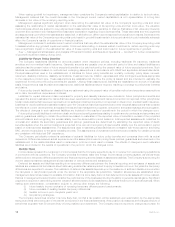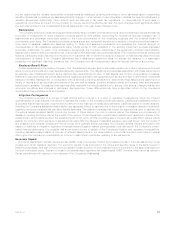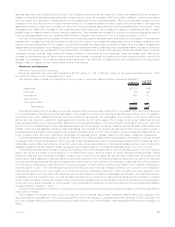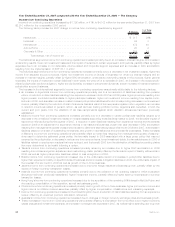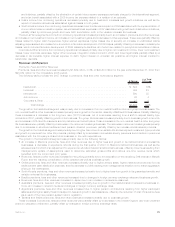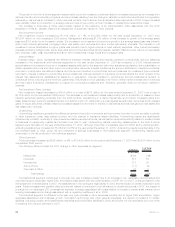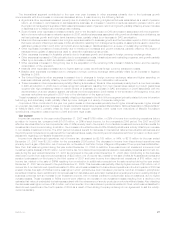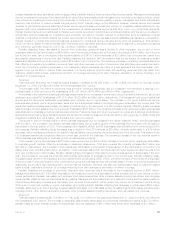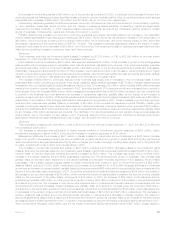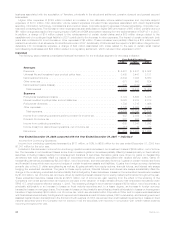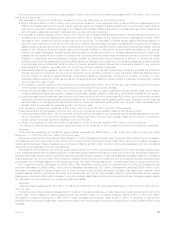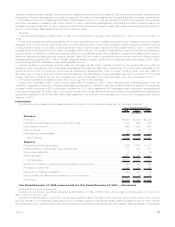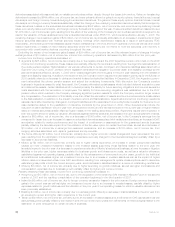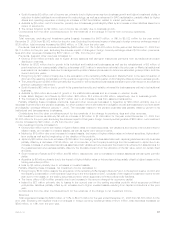MetLife 2008 Annual Report Download - page 30
Download and view the complete annual report
Please find page 30 of the 2008 MetLife annual report below. You can navigate through the pages in the report by either clicking on the pages listed below, or by using the keyword search tool below to find specific information within the annual report.The International segment contributed to the year over year increase in other expenses primarily due to the business growth
commensurate with the increase in revenues discussed above. It was driven by the following factors:
• Argentina’s other expenses increased primarily due to a liability for servicing obligations that was established as a result of pension
reform, an increase in commissions on bancassurance business, an increase in retention incentives related to pension reform, and
the impact of management’s update of DAC assumptions as a result of pension reform and growth, partially offset by a lower increase
in liabilities due to inflation and exchange rate indexing.
• South Korea’s other expenses increased primarily due to the favorable impact in DAC amortization associated with the implemen-
tation of a more refined reserve valuation system in 2006, additional expenses associated with growth and infrastructure initiatives, as
well as business growth and higher bank insurance fees, partially offset by a decrease in DAC amortization.
• Mexico’s other expenses increased due to higher expenses related to business growth and the favorable impact in 2006 of liabilities
that were reduced, offset by a decrease in DAC amortization resulting from management’s update of assumptions used to determine
estimated gross profits in both 2007 and 2006 and a decrease in liabilities based on a review of outstanding remittances.
• Other expenses increased in India primarily due to headcount increases and growth initiatives, partially offset by the impact of
management’s update of assumptions used to determine estimated gross profits.
• Other expenses increased in Australia primarily due to business growth and changes in foreign currency exchange rates.
• Other expenses increased in Chile primarily due to compensation costs, infrastructure and marketing programs, and growth partially
offset by a decrease in DAC amortization related to inflation indexing.
• Other expenses increased in Hong Kong due to the acquisition of the remaining 50% interest in MetLife Fubon and the resulting
consolidation of the operation.
• Ireland’s other expenses increased due to higher start-up costs, as well as foreign currency transaction losses.
• Brazil’s other expenses increased due to changes in foreign currency exchange rates partially offset by an increase in litigation
liabilities in 2006.
• The United Kingdom’s other expenses increased due to changes in foreign currency exchange rates and higher spending on
business initiatives partially offset by lower DAC amortization resulting from calculation refinements.
• These increases in other expenses were partially offset by a decrease in Taiwan’s other expenses primarily due to a one-time increase
in DAC amortization in 2006 due to a loss recognition adjustment resulting from low interest rates related to product guarantees
coupled with high persistency rates on certain blocks of business, an increase in DAC amortization in 2006 associated with the
implementation of a new valuation system, as well as one-time expenses in 2006 related to the termination of the agency force, and
expense reductions recognized in 2007 due to the elimination of the agency force.
These increases in other expenses were partially offset by a decrease in the Auto & Home segment primarily related to lower information
technology and advertising costs, partially offset by minor changes in a variety of expense categories.
Corporate & Other contributed to the year over year increase in other expenses primarily due to higher interest expense, higher interest
on uncertain tax positions and an increase in interest credited to bankholder deposits at MetLife Bank, National Association (“MetLife Bank”
or “MetLife Bank, N.A.”), partially offset by lower corporate support expenses, lower costs from reductions of MetLife Foundation
contributions, integration costs incurred in 2006 and lower legal costs.
Net Income
Income tax expense for the year ended December 31, 2007 was $1,660 million, or 29% of income from continuing operations before
provision for income tax, compared with $1,016 million, or 26% of such income, for the comparable 2006 period. The 2007 and 2006
effective tax rates differ from the corporate tax rate of 35% primarily due to the impact of non-taxable investment income and tax credits for
investments in low income housing. In addition, the increase in the effective rate for FIN 48 liability additions is entirely offset by an increase
in non-taxable investment income. The 2007 period includes a benefit for decrease in international deferred tax valuation allowances and
the 2006 period included a prior year benefit for international taxes. Lastly, the 2006 period included benefit for a “provision-to-filed return”
adjustment regarding non-taxable investment income.
Income from discontinued operations, net of income tax, decreased by $3,168 million, or 94%, to $215 million for the year ended
December 31, 2007 from $3,383 million for the comparable 2006 period. The decrease in income from discontinued operations was
primarily due to a gain of $3 billion, net of income tax, on the sale of the Peter Cooper Village and Stuyvesant Town properties in Manhattan,
New York, that was recognized during the year ended December 31, 2006. In addition, there was lower net investment income and net
investment gains (losses) of $148 million, net of income tax, from discontinued operations related to real estate properties sold or held-for-
sale during the year ended December 31, 2007 as compared to the year ended December 31, 2006. Also contributing to the decrease
was lower income from discontinued operations of $23 million, net of income tax, related to the sale of MetLife Australia’s annuities and
pension businesses to a third party in the third quarter of 2007 and lower income from discontinued operations of $18 million, net of
income tax, related to the sale of SSRM resulting from a reduction in additional proceeds from the sale received during the year ended
December 31, 2007 as compared to the year December 31, 2006. This decrease was partially offset by higher income of $7 million, net of
income tax, from discontinued operations related to RGA, which was reclassified to discontinued operations in the third quarter of 2008 as
a result of a tax-free split off. RGA’s income was higher in 2007, primarily due to an increase in premiums, net of an increase in policyholder
benefits and claims, due to additional in-force business from facultative and automatic treaties and renewal premiums on existing blocks of
business combined with an increase in net investment income, net of interest credited to policyholder account balances, due to higher
invested assets. These increases in RGA’s income were offset by an increase in net investment losses resulting from a decline in the
estimated fair value of embedded derivatives associated with the reinsurance of annuity products on a funds withheld basis. Also offsetting
the decrease was higher income of $14 million, net of income tax, from discontinued operations related to Cova, which was reclassified to
discontinued operations in the fourth quarter of 2008 as a result of the Holding Company entering into an agreement to sell the wholly-
owned subsidiary.
27MetLife, Inc.



